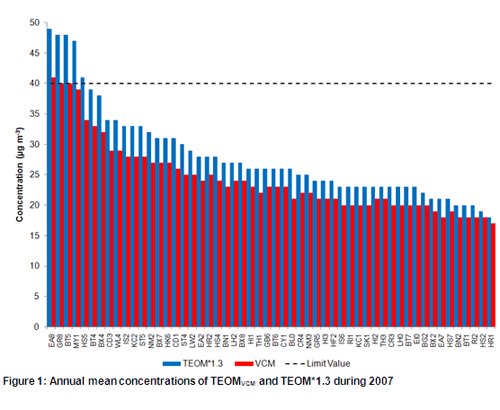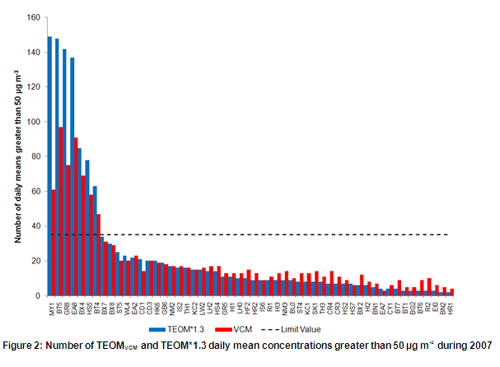| Particulate pollution is unlike other pollutants as it can't be defined as a single gas or chemical. It is made up of a constantly varying mixture of small particles from many different sources, each with very different properties. The particles can vary in size, shape, number, toxicity and chemical composition. This makes the task of monitoring concentrations very difficult. |
| A number of very different monitoring methods have been developed, each with its own advantages and disadvantages. As each method is so different, data from each method of particulate monitoring are not directly comparable. Where ever possible, we have indicated which type of analyser is used at each site. Great care should be taken when comparing results from different methods. |
| Reference Equivalent PM10 measurements |
| The TEOM has been used to measure PM10 since the early 1990's and is the most widespread particulate analyser in the UK, however, the elevated temperature that it employs to eliminate water from the sample also leads to the loss of volatile PM. To account for this loss, Defra recommended that TEOM measurements were corrected using a factor of 1.3. This was known to be a precautionary approach likely to overestimate the PM10 concentration. |
| For the assessment of the EU Limit Values, PM10 needs to be measured using the reference method or one shown to be equivalent to the reference method. Defra carried out extensive trials between 2004 and 2006 to establish which types of particulate analysers in use in the UK were equivalent. These trials found that measurements made using Partisol, FDMS, BAM and SM200 instruments were shown to be equivalent to the PM10 reference method. However, correction factors need to be applied to measurements from the SM200 and BAM instruments. Importantly, the TEOM was demonstrated as not being equivalent to the reference method due to the loss of volatile PM, even when the 1.3 correction factor was applied. |
| The Volatile Correction Model (VCM) was developed for Defra at King's to allow measurements of PM10 from TEOM instruments to be converted to reference equivalent; it uses the measurements of volatile PM made using nearby FDMS instruments to correct the measurements made by the TEOM. It passed the equivalence testing using the same methodology used in the Defra trials and is now the recommended method for correcting TEOM measurements (Defra, 2009). VCM correction of TEOM measurements can only be applied after 1st January 2004, when sufficiently widespread measurements of volatile PM became available. The 1.3 correction factor is now considered redundant for measurements of PM10 made after 1st January 2004. |
| Further information on the VCM can be found at http://www.volatile-correction-model.info/. |
| All PM10 statistics on the LondonAir web site, including the bulletins and statistical tools, now report PM10 results as reference equivalent. For PM10 measurements made by BAM and SM200 analysers the applicable correction factors have been applied. For measurements from TEOM analysers the 1.3 factor has been applied up to 1st January 2004, then the VCM method has been used to convert to reference equivalent. |
| In most instances, we will additionally continue to report PM10 results using the TEOM*1.3 method for continuity and to allow comparison with results prior to 2004. In such situations, the results will be reported as 'PM10 (redundant method)'. Furthermore, both unconverted and reference equivalent measurements may be downloaded from the data download section of the pages. Further trials are now underway to establish a similar set of reference equivalent measurements for PM2.5 and a wider range of PM10 monitoring instruments. |
| Effect of different correction methods |
| The change in correction methodology from TEOM*1.3 to VCM has implications for the assessment of the EU Limit Values as they provide different results; these are illustrated by the charts below for 2007. |

|

|
| In general, the 1.3 correction factor overestimates the annual mean PM10 concentration. Measurements have shown that the volatile PM fraction can be considered uniform over a wide area and is the same concentration at both background and roadside location. This leads the 1.3 correction factor to overestimate the PM10 annual mean most at roadside locations as 30% of the TEOM PM10 concentration at a roadside location is larger than 30% at a background location. |
| The implications of the change in correction methodology for the daily mean Limit Value is more complex as it depends on local and regional episodes. For the reasons described above, the 1.3 correction factor overestimates the number of daily means greater than 50 µg m-3 at roadside sites. However, as the VCM measures the volatile PM characteristic of regional episodes, there is a greater uniformity in the number of breaches of the daily mean Limit Value between background and roadside sites. |
| This analysis is indicative of a 'normal' year; there can be increases in the number of regional episodes (e.g. 2003). This would increase the number of episodes at both background and roadside sites and to a lesser extent the annual mean concentrations. |
| References and further information |
| Volatile Correction Model web portal: http://www.volatile-correction-model.info/.
Defra, 2009. Local air quality management technical guidance LAQM.TG(09), Part IV of the Environment Act 1995 Environment (Northern Ireland) Order 2002 Part III. Department of the Environment, Transport and the Regions, the Welsh Office, the Scottish Office and the Department of the Environment (Northern Ireland) (Defra), London. (www.defra.gov.uk/environment/airquality/index.htm) |
| Go back to the site stats page |
Follow Us
Our newsletter
 Privacy Notice Summary:
Privacy Notice Summary:
- Who this is for: You must be at least 13 years old to use this service.
- What we collect: We store your email address
- Who we share it with: We use "Campaign Monitor" to store it, and do not share it with anyone else.
- More Info: You can see our full privacy notice here
AirMail newsletter
The latest news and research from ERG: View the archive
